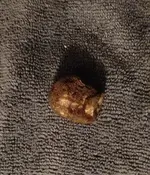The "content" of the metal greatly influences the amount and COLOR of oxidation. Extremely pure lead tends to get a white or greyish-white oxidation layer on it. Lead which was alloyed with another metal such as zinc or antimony to increase the lead's hardness will develop much less oxidation. An example of that: the civil war Gardiner Explosive minies, which NEVER have the classic white patina of pure lead, because they are made of a lead alloy. Another example is the filler-metal in the back of US Oval belt buckles, cartridge boxplates, and eagle-breastplates. Despite most diggers calling them "lead filled" they are actually filled with a solder-like lead alloy, therefore you never see those buckles/plates with milk-white patina on the back. (Solder was used as the filler-metal because pure lead doesn't "stick" very well to the brass body of the buckle/plate.) If you do see one with milk-white patina on the filler-metal, it is probably an artificially aged Reproduction buckle/plate... because those actually ARE filled with lead.
"Impure" lead was often used to make musketballs. Whatever white-metal scraps which would melt at a low-ish temperature were tossed into the pot. That's another reason for "strange" or very little or no patina/oxide on some excavated musketballs.



